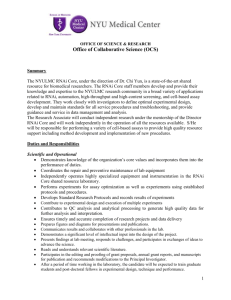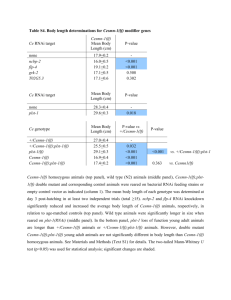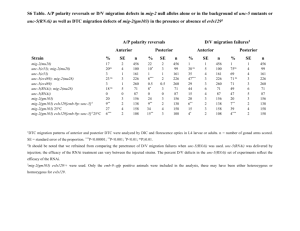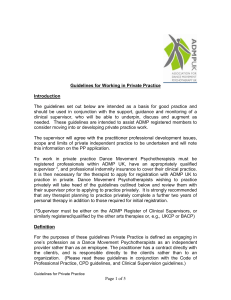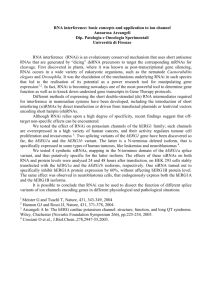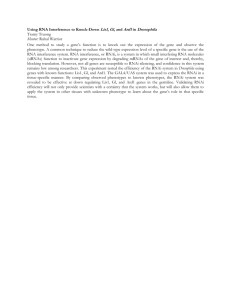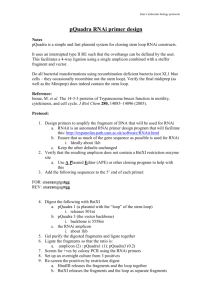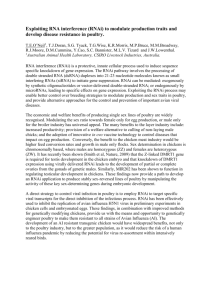A Bmp/Admp Regulatory Circuit Controls Maintenance
advertisement
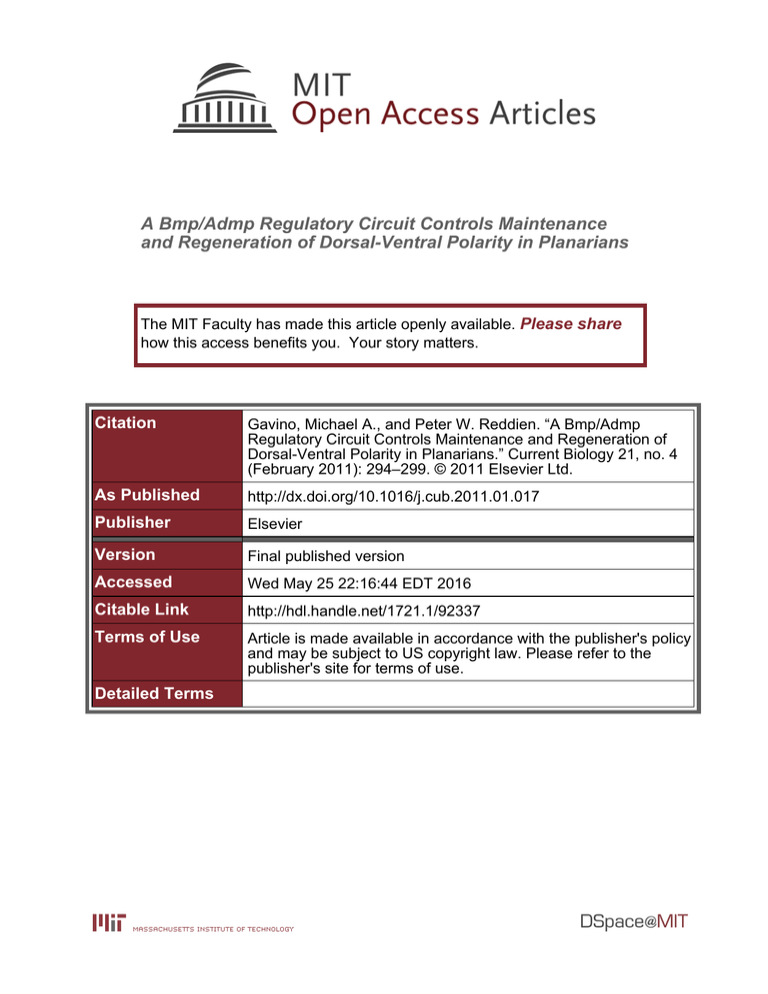
A Bmp/Admp Regulatory Circuit Controls Maintenance and Regeneration of Dorsal-Ventral Polarity in Planarians The MIT Faculty has made this article openly available. Please share how this access benefits you. Your story matters. Citation Gavino, Michael A., and Peter W. Reddien. “A Bmp/Admp Regulatory Circuit Controls Maintenance and Regeneration of Dorsal-Ventral Polarity in Planarians.” Current Biology 21, no. 4 (February 2011): 294–299. © 2011 Elsevier Ltd. As Published http://dx.doi.org/10.1016/j.cub.2011.01.017 Publisher Elsevier Version Final published version Accessed Wed May 25 22:16:44 EDT 2016 Citable Link http://hdl.handle.net/1721.1/92337 Terms of Use Article is made available in accordance with the publisher's policy and may be subject to US copyright law. Please refer to the publisher's site for terms of use. Detailed Terms Current Biology 21, 294–299, February 22, 2011 ª2011 Elsevier Ltd All rights reserved DOI 10.1016/j.cub.2011.01.017 Report A Bmp/Admp Regulatory Circuit Controls Maintenance and Regeneration of Dorsal-Ventral Polarity in Planarians Michael A. Gaviño1 and Peter W. Reddien1,* 1Howard Hughes Medical Institute, Whitehead Institute and Department of Biology, Massachusetts Institute of Technology, 9 Cambridge Center, Cambridge, MA 02142, USA Summary Animal embryos have diverse anatomy and vary greatly in size. It is therefore remarkable that a common signaling pathway, BMP signaling, controls development of the dorsoventral (DV) axis throughout the Bilateria [1–8]. In vertebrates, spatially opposed expression of the BMP family proteins Bmp4 and Admp (antidorsalizing morphogenetic protein) can promote restoration of DV pattern following tissue removal [9–11]. bmp4 orthologs have been identified in all three groups of the Bilateria (deuterostomes, ecdysozoans, and lophotrochozoans) [12]. By contrast, the absence of admp orthologs in ecdysozoans such as Drosophila and C. elegans has suggested that a regulatory circuit of oppositely expressed bmp4 and admp genes represents a deuterostome-specific innovation. Here we describe the existence of spatially opposed bmp and admp expression in a protostome. An admp ortholog (Smed-admp) is expressed ventrally and laterally in adult Schmidtea mediterranea planarians, opposing the dorsal-pole expression of Smed-bmp4. Smedadmp is required for regeneration following parasagittal amputation. Furthermore, Smed-admp promotes Smedbmp4 expression and Smed-bmp4 inhibits Smed-admp expression, generating a regulatory circuit that buffers against perturbations of Bmp signaling. These results suggest that a Bmp/Admp regulatory circuit is a central feature of the Bilateria, used broadly for the establishment, maintenance, and regeneration of the DV axis. Results and Discussion Spatially Opposed Expression of Bmp and Admp Genes in Adult Planarians Planarians are flatworms famous for their regenerative capacities. The ability of planarians to regenerate entire adult animals from small tissue fragments makes them well suited for the study of body axis polarization and patterning [13]. Furthermore, their phylogenetic position as a member of the protostome superphylum Lophotrochozoa makes them ideal for identifying features that are conserved across the Bilateria. Planarians utilize a dorsally expressed bmp4 ortholog, Smedbmp4 (in short, bmp4), to maintain and regenerate the dorsoventral (DV) axis [2–4]. We isolated a putative admp ortholog in the planarian Schmidtea mediterranea that is, to our knowledge, the first characterized in a protostome [14–16] (see Figure S1 available online and functional data below). We cloned two highly similar admp sequences (Smed-admp-1a and Smed-admp-1b; see Figure S1 and Supplemental Experimental Procedures for details); it is unknown whether these *Correspondence: reddien@wi.mit.edu sequences reflect the existence of distinct admp alleles or of highly similar admp paralogs. We refer to a single gene in this text as Smed-admp (in short, admp). admp expression was detected in subepidermal cells on the ventral animal midline and around lateral animal edges at the dorsal/ventral boundary (Figures 1A and 1B). These ventral and lateral domains spatially oppose the bmp4 expression domain on the dorsal midline. Double labeling with admp and bmp4 RNA probes revealed that expression of these genes does not detectably overlap (Figure 1C). admp expression opposing bmp4 expression in planarians is noteworthy, because it provides the first example of spatially opposed bmp and admp expression outside of the deuterostome lineage. Following head and tail amputation, lateral admp expression first appeared at wound sites by 48 hr, whereas ventral admp expression decreased at 24 hr, 48 hr, and 60 hr before increasing again at 72 hr (Figure S2A). These data indicate that ventral admp expression is regulated following transverse amputation, possibly by wound-induced factors. admp expression was not detected dorsally at any point during regeneration (Figure S2A). Together, admp and bmp4 form complementary expression domains that identify the dorsal and ventral midlines, as well as the lateral, dorsal-ventral boundary, of animals. Smed-admp Is Required for Lateral Planarian Regeneration To investigate the role of admp in regeneration, we inhibited admp expression with RNA interference (RNAi) and amputated animal heads and tails. Planarian regeneration involves new tissue outgrowth at wound sites called a blastema [13]. admp(RNAi) fragments displayed regeneration defects including indented head and tail blastemas, a hallmark phenotype of planarian Bmp pathway dysfunction [2, 3], as well as uncoordinated movement (Figure 2A, Movie S1, and Movie S2). In situ hybridization with a marker for lateral-edge cells identified defects in regeneration of lateral DV boundary tissue (Figure 2B). We conclude that admp is required for the regeneration of tissues at lateral animal edges, at the midpoint between dorsal and ventral poles, following transverse amputation. Bmp signaling is crucial for lateral planarian regeneration following sagittal amputations [2, 3]. Parasagittal amputation produces two left-right asymmetric fragments: a thin fragment that must regenerate an appropriately sized bmp4 expression domain de novo, and a thick fragment that must reposition and rescale its bmp4 expression domain to accommodate new animal dimensions. Parasagittal amputations therefore present a stringent test of establishment and scaling of DV, as well as medial-lateral (ML), pattern. admp(RNAi) thin fragments were able to regenerate some structures along the anteroposterior (AP) axis within preexisting tissue (photoreceptors and pharynx); however, they failed to regenerate a new side and corresponding lateral marker expression (Figure 2C). admp(RNAi) thick fragments also failed to regenerate a side (Figures 2C and 2D; Figure S2D). Furthermore, nonamputated admp(RNAi) animals displayed aberrant body dimensions and ML marker expression following several months of admp inhibition (Figure 2E, Figure S3, and Movie S3), A Bmp/Admp Regulatory Circuit in Planarians 295 A C B admp / bmp4 admp pr dorsal side admp DAPI pr dorsal ventral admp DAPI pr pr ventral lateral ventral Figure 1. Smed-admp Is Expressed Ventrally and Laterally (A) In situ hybridization with admp RNA probe displayed ventral and lateral expression. (B) Transverse sections (20 mm), differential interference contrast (DIC) images: admp-expressing cells were subepidermal (yellow arrowheads). White lines represent epidermis. (C) Wild-type animals double labeled with admp (green) and bmp4 (red) RNA probes. pr denotes photoreceptors. Scale bars represent 200 mm for (A) and (C) and 20 mm for (B). Anterior is up. suggesting that admp is crucial for maintaining body form and proper ML pattern during animal homeostasis. We conclude that admp is required for lateral planarian regeneration and ML pattern maintenance. Smed-admp Promotes Smed-bmp4 Expression The indented head and tail blastemas and the failed lateral regeneration in admp(RNAi) animals are consistent with a defect in Bmp signaling [2, 3]. bmp4 promotes dorsal tissue maintenance and regeneration; we therefore investigated the role of admp in DV patterning. Whereas animals inhibited for admp expression alone did not show dorsal expansion of ventral markers, admp(RNAi) animals exposed to a low dose of bmp4 double-stranded RNA (dsRNA) became more ventralized near wound sites than did control animals exposed to the same bmp4 dsRNA dose (Figure 3A). These results indicate that animals depleted of admp activity become hypersensitive to small decreases in Bmp signaling level during DV axis regeneration. We next assessed whether admp influences bmp4 expression. Thin fragments produced by parasagittal amputation must reexpress bmp4 during regeneration. admp(RNAi) thin fragments displayed reduced bmp4 expression, and this expression domain did not reposition to reflect a new dorsal midline (Figure 3B). These results indicate that admp promotes bmp4 expression and controls the positioning of bmp4 expression during regeneration of left-right asymmetric fragments. Whether Admp signaling regulates bmp4 expression by direct action or through some other mechanism is unknown. In addition to regenerating, planarians undergo extensive tissue turnover and growth as adults—processes that also require patterning genes for instructing new cell identities [17–19]. Consequently, if admp promotes bmp4 expression, nonamputated admp(RNAi) animals should display reduced bmp4 expression. Quantitative RT-PCR confirmed that bmp4 expression was reduced in intact admp(RNAi) animals (Figure 3C). This decrease in bmp4 expression was particularly apparent in cells more distal from the dorsal midline (Figure 3C). Together, these data indicate that Admp signaling is required to maintain the appropriate level and broad spatial distribution of bmp4 expression during adult tissue maintenance and growth. Smed-bmp4 Inhibits Smed-admp Expression To determine whether admp is regulated by Bmp4 signaling, we examined the effect of Bmp pathway inhibition on admp expression. In both transversely and parasagittally amputated bmp4(RNAi) animals, admp expression was increased and expanded dorsally (Figures 4A and 4B). To conversely test whether an increase in Bmp signaling leads to a reduction in admp expression, we inhibited a ventrally expressed planarian noggin homolog (Smed-nog1, or nog1 in short) [3]. Noggins are well-characterized inhibitors of Bmp signaling [20]. Parasagittally amputated nog1(RNAi) animals indeed displayed a marked decrease in ventral admp expression (Figure 4B). Together these results indicate that admp expression is negatively regulated by Bmp signaling. We next investigated whether the change in admp expression observed in bmp4(RNAi) animals reflected failure of specific regulation of admp or whether it was the simple consequence of ventralization. Following Bmp pathway inhibition, we compared expression of admp to genes with similar ventral or lateral expression domains. Whereas regeneration occurs quickly (within days), intact nonamputated animals inhibited for bmp4 or the Bmp effectors smad1 or smad4 gradually become ventralized over a period of weeks [2, 3]. This slow transformation allows for greater temporal resolution in assessing the changes in gene expression that occur following Bmp signaling loss. After 3 weeks of RNAi, intact bmp4(RNAi), smad1(RNAi), and smad4(RNAi) animals all displayed dorsal expression of admp, despite little to no expansion in the Current Biology Vol 21 No 4 296 control RNAi control RNAi C admp(RNAi) admp(RNAi) control RNAi admp(RNAi) * pr pr pr pr laminB laminB A * D control RNAi pr control RNAi admp(RNAi) 0.10 0.08 *** 0.06 150+ days RNAi 0.04 0.02 0.00 control RNAi Control RNAi admp(RNAi) admp(RNAi) slit Tail laminB, α-Arrestin pr pr Head pr admp(RNAi) E Blastema area/ total area B Figure 2. Smed-admp Is Required for Planarian Regeneration (A) Transversely amputated admp(RNAi) animals displayed aberrant midline regeneration (yellow asterisks, n = 14 of 20). pr denotes photoreceptors. Scale bars represent 200 mm. (B) Transversely amputated admp(RNAi) animals failed to regenerate cells at the DV boundary, as assayed by detection of laminB+ cells (yellow arrowheads, n = 7 of 7). Scale bars represent 200 mm. (C) admp(RNAi) animals failed to regenerate a missing side (yellow arrowheads, n = 22 of 26 thin and 19 of 19 thick fragments) or lateral laminB+ tissue (black arrowhead, n = 13 of 16 thin and 19 of 19 thick fragments) following parasagittal amputation. Scale bars represent 500 mm (top) and 200 mm (bottom). (D) Blastema size: unpigmented tissue at amputated sides (thick fragments), from anterior pharynx tip to tail, divided by worm area (difference with control was significant, p = 0.0006, unpaired t test). (E) Nonamputated admp(RNAi) animals became thinner than control animals following 155 days of RNAi and aberrantly expressed the ventral midline marker slit [31] at lateral positions following 163 days of RNAi (n = 7 of 7, black arrowheads). RNAi of admp was shown to be effective and specific (see Figures S2B and S2C). White lines in (A)–(C) denote approximate blastema boundary. Dorsal view in (A)–(C) and (E), top; ventral view in (E), bottom. Anterior is up in all. expression of other tested genes (Figure 4C). Strikingly, smad4 inhibition resulted in broad dorsal expansion of admp expression after 3 weeks of RNAi and in ubiquitous DV expression of admp after 82 days of RNAi (Figure 4D). In both of these cases, inhibition of smad4 resulted in more extensive dorsal expression of admp than did inhibition of either smad1 or bmp4 (Figure 4C and Figure S4C). Because Smad4 proteins are required for all forms of TGFb superfamily signaling [21], these results suggest that admp expression may also be regulated by non-Bmp TGFb signaling. In contrast to Bmp pathway RNAi, 3 weeks of nog1 RNAi in intact animals caused a potent reduction in the ventral admp expression domain without affecting other ventral markers (Figure 4D and Figure S4A). These data indicate that admp expression is negatively regulated by Bmp signaling during adult homeostasis and growth. Together with the observation that admp promotes bmp4 expression, we propose that inhibition of admp expression by Bmp4 produces a feedback circuit that buffers against fluctuations in Bmp signaling levels, conferring robustness in DV and ML patterning. This model is supported by the observation that admp depletion results in animals that are hypersensitive to bmp4 inhibition. Although planarians lack identified orthologs of the Bmp modulators chordin [22] and sizzled [23], the presence of a homolog of the Bmp pseudoreceptor bambi [24] (Figure S4D), as well as a greatly expanded family of noggin genes [25] and the ability of Admp to regulate nog1 expression (Figures S2D and S3D), suggests that additional regulatory mechanisms likely function to fine-tune the activity of this central Bmp/Admp circuit. Admp Orthologs Are Widespread among Protostomes Because Smed-admp represents the first admp ortholog characterized in a protostome, we searched the genomes of other lophotrochozoans to determine whether admp orthologs are widespread in protostomes. Indeed, predicted admp orthologs were identified in the genomes of the snail Lottia gigantis, the leech Helobdella robusta, and the polychaete annelid Capitella teleta (Figure S1C). The presence of putative admp orthologs in these species, coupled with the expression pattern and functional properties of Smed-admp, suggest that a Bmp/Admp regulatory circuit is an ancestral and central feature of the DV axis (Figure 4E). This model predicts that an admp gene was present in the ancestor of C. elegans and Drosophila but was subsequently lost in the evolution of these A Bmp/Admp Regulatory Circuit in Planarians 297 B eye53 30 20 10 control RNAi Control RNAi 4 days 0 0.0005 admp(RNAi) control RNAi 0.0004 lateral thin Tail, dorsal mid admp(RNAi) mid *** 0.0003 bmp4 Relative bmp4 expression *** 40 admp(RNAi) 2 days Head, dorsal C control RNAi bmp4 control RNAi + bmp4(RNAi) admp(RNAi) + bmp4(RNAi) Number dorsal eye53-positive cells A 0.0002 0.0001 0.0000 Control RNAi control admp(RNAi) admp(RNAi) lat 18/18 lat 19/19 Figure 3. Smed-admp Inhibits Ventral Fates and Is Required for Normal Smed-bmp4 Expression (A) bmp4 dsRNA addition in admp(RNAi) animals caused ectopic dorsal eye53 expression (black arrowheads). Out-of-focus signal in control animals is from ventral cells. Difference in dorsal eye53-expressing cell numbers was significant, p < 0.0001, unpaired t test. RNAi of bmp4 was shown to be effective (see Figure S4B). (B) admp(RNAi) thin fragments had reduced bmp4 expression (black arrowheads, n = 5 of 6 and n = 9 of 15 at 2 and 4 days, respectively) and failed to reposition bmp4 expression as in control animals (white arrow). (C) Left: bmp4 expression was reduced in intact admp(RNAi) animals (by quantitative RT-PCR). Difference was significant, p < 0.0001, paired t test.Right: bmp4 expression depiction. Eight micron optical sections images were acquired, with identical exposure times, of the postpharyngeal left side of intact admp(RNAi) and control RNAi animals. admp(RNAi) animals had reduced bmp4 expression (37 of 37 animals blindly scored correctly, three independent experiments). mid denotes medial dorsal, lat denotes lateral dorsal. White lines denote approximate lateral animal edge. Scale bars represent 200 mm for (A) and (B) and 20 mm for (C). Dorsal view, anterior is up. species; consequently, the potential widespread significance of admp genes for the DV axis of Bilaterians was previously unknown. Conclusions Development proceeds in a remarkably reliable fashion despite the myriad forms that embryos assume and the widely varying conditions they encounter [26]. Robust patterning of the DV axis is a crucial component of this process. The DV axis can scale during growth and, in some cases, is capable of restoration following surgical manipulation [9, 27–29]. How Bmp signaling is able to generate consistent DV pattern in diverse species and respond appropriately to perturbation has been a central mystery in developmental biology. Our data demonstrate that a molecular circuit of spatially opposed bmp4 and admp expression is crucial for the regeneration and maintenance of both DV and ML pattern in planarians. This circuit may function to buffer against changes in Bmp level that naturally arise from differences in patterned tissue size, the genotype of individuals, or environmental influences encountered. The requirement of a Bmp/Admp circuit for both planarian regeneration and deuterostome self-regulation [10, 11, 16] suggests that restoration of the DV axis in embryonic regulation and adult axial regeneration share mechanistic features. The presence of spatially opposed expression of bmp and admp in planarians (lophotrochozoans) and in several deuterostomes [15, 16, 30] suggests that a Bmp/ Admp circuit is a widespread feature of the DV axis that emerged concurrent with the first bilaterally symmetric animals. Supplemental Information Supplemental Information includes four figures, Supplemental Experimental Procedures, and three movies and can be found with this article online at doi:10.1016/j.cub.2011.01.017. Acknowledgments We thank the Reddien laboratory for discussions and support and Irving Wang for his artistic contributions. P.W.R. is an Early Career Scientist of the Howard Hughes Medical Institute. We acknowledge support by National Institutes of Health R01GM080639, American Cancer Society RSG-07-18001-DDC, the Keck Foundation, and a Thomas D. and Virginia W. Cabot career development professorship. Received: July 7, 2010 Revised: November 19, 2010 Accepted: January 6, 2011 Published online: February 3, 2011 References 1. Lowe, C.J., Terasaki, M., Wu, M., Freeman, R.M., Jr., Runft, L., Kwan, K., Haigo, S., Aronowicz, J., Lander, E., Gruber, C., et al. (2006). Current Biology Vol 21 No 4 298 control RNAi bmp4(RNAi) C smad1(RNAi) smad4(RNAi) control RNAi nog1(RNAi) laminB eye53 dorsal 82 days ventral C. elegans (no ADMP) admp thick, dorsal Drosophila (no ADMP) E Molluscs (ADMP) thin, dorsal Platyhelminthes (ADMP) Bilaterian Ancestor (ADMP) Annelids (ADMP) Deuterostomes (ADMP) ventral, 21 days nog1(RNAi) thin, ventral netrin1 control RNAi admp control RNAi dorsal B D smad4(RNAi) admp bmp4(RNAi) tail admp control RNAi dorsal 21 days bmp4(RNAi) head control RNAi admp A Xenopus Planaria Figure 4. Smed-admp Expression Is Negatively Regulated by Bmp Signaling (A) Transversely amputated bmp4(RNAi) animals had ectopic, dorsal admp expression (black arrowheads, n = 14 of 14) in preexisting tissue. Nineteen days of regeneration, dorsal view. Dotted lines denote blastema boundary. (B) Parasagittally amputated bmp4(RNAi) animals had ectopic dorsal admp expression (black arrowheads, n = 5 of 5) in preexisting tissue; parasagittally amputated nog1(RNAi) animals had reduced ventral admp expression (white arrows, n = 20 of 20). Fourteen and 19 days of regeneration for bmp4 (RNAi) and nog1(RNAi) animals, respectively. (C) Nonamputated animals inhibited for Bmp pathway components displayed ectopic dorsal admp expression after 21 days of RNAi (yellow arrowheads, n > 9 of 9 for each condition). Weak dorsal expression of the ventral marker eye53 was detected in smad4(RNAi) animals (white arrowheads, n = 5 of 11). Ventral and lateral marker expression was otherwise unaffected. (D) Nonamputated smad4(RNAi) animals displayed broad dorsal admp expression after 21 days of RNAi (yellow arrowheads, n = 23 of 23) and ubiquitous admp expression after 82 days of RNAi (n = 5 of 5). Nonamputated nog1(RNAi) animals displayed reduced ventral admp expression (white arrows, n = 8 of 8) but normal netrin1 expression. (E) Top: phylogenetic diagram of bilaterians annotated with the existence of putative admp orthologs. Bottom: schematic of proposed conserved BmpAdmp circuit in Xenopus embryos (left) and planarians (right). RNAi of smad1, smad4, and nog1 was shown to be effective (see Figure S4B). Scale bars represent 100 mm for (A) and (C) and 200 mm for (B) and (D). Anterior is up. Dorsoventral patterning in hemichordates: Insights into early chordate evolution. PLoS Biol. 4, e291. 2. Reddien, P.W., Bermange, A.L., Kicza, A.M., and Sánchez Alvarado, A. (2007). BMP signaling regulates the dorsal planarian midline and is needed for asymmetric regeneration. Development 134, 4043–4051. 3. Molina, M.D., Saló, E., and Cebrià, F. (2007). The BMP pathway is essential for re-specification and maintenance of the dorsoventral axis in regenerating and intact planarians. Dev. Biol. 311, 79–94. 4. Orii, H., and Watanabe, K. (2007). Bone morphogenetic protein is required for dorso-ventral patterning in the planarian Dugesia japonica. Dev. Growth Differ. 49, 345–349. 5. De Robertis, E.M., and Sasai, Y. (1996). A common plan for dorsoventral patterning in Bilateria. Nature 380, 37–40. 6. Ferguson, E.L., and Anderson, K.V. (1992). Decapentaplegic acts as a morphogen to organize dorsal-ventral pattern in the Drosophila embryo. Cell 71, 451–461. 7. Hammerschmidt, M., Serbedzija, G.N., and McMahon, A.P. (1996). Genetic analysis of dorsoventral pattern formation in the zebrafish: Requirement of a BMP-like ventralizing activity and its dorsal repressor. Genes Dev. 10, 2452–2461. 8. Dale, L., Howes, G., Price, B.M., and Smith, J.C. (1992). Bone morphogenetic protein 4: A ventralizing factor in early Xenopus development. Development 115, 573–585. 9. Spemann, H. (1938). Embryonic Development and Induction (New Haven, CT: Yale University Press). 10. Reversade, B., and De Robertis, E.M. (2005). Regulation of ADMP and BMP2/4/7 at opposite embryonic poles generates a self-regulating morphogenetic field. Cell 123, 1147–1160. 11. Ben-Zvi, D., Shilo, B.Z., Fainsod, A., and Barkai, N. (2008). Scaling of the BMP activation gradient in Xenopus embryos. Nature 453, 1205–1211. 12. Niehrs, C. (2010). On growth and form: A Cartesian coordinate system of Wnt and BMP signaling specifies bilaterian body axes. Development 137, 845–857. 13. Reddien, P.W., and Sánchez Alvarado, A. (2004). Fundamentals of planarian regeneration. Annu. Rev. Cell Dev. Biol. 20, 725–757. 14. Moos, M., Jr., Wang, S., and Krinks, M. (1995). Anti-dorsalizing morphogenetic protein is a novel TGF-beta homolog expressed in the Spemann organizer. Development 121, 4293–4301. 15. Lele, Z., Nowak, M., and Hammerschmidt, M. (2001). Zebrafish admp is required to restrict the size of the organizer and to promote posterior and ventral development. Dev. Dyn. 222, 681–687. A Bmp/Admp Regulatory Circuit in Planarians 299 16. Joubin, K., and Stern, C.D. (1999). Molecular interactions continuously define the organizer during the cell movements of gastrulation. Cell 98, 559–571. 17. Petersen, C.P., and Reddien, P.W. (2008). Smed-betacatenin-1 is required for anteroposterior blastema polarity in planarian regeneration. Science 319, 327–330. 18. Gurley, K.A., Rink, J.C., and Sánchez Alvarado, A. (2008). Beta-catenin defines head versus tail identity during planarian regeneration and homeostasis. Science 319, 323–327. 19. Iglesias, M., Gomez-Skarmeta, J.L., Saló, E., and Adell, T. (2008). Silencing of Smed-betacatenin1 generates radial-like hypercephalized planarians. Development 135, 1215–1221. 20. Zimmerman, L.B., De Jesús-Escobar, J.M., and Harland, R.M. (1996). The Spemann organizer signal noggin binds and inactivates bone morphogenetic protein 4. Cell 86, 599–606. 21. Zhang, Y., Musci, T., and Derynck, R. (1997). The tumor suppressor Smad4/DPC 4 as a central mediator of Smad function. Curr. Biol. 7, 270–276. 22. Sasai, Y., Lu, B., Steinbeisser, H., Geissert, D., Gont, L.K., and De Robertis, E.M. (1994). Xenopus chordin: A novel dorsalizing factor activated by organizer-specific homeobox genes. Cell 79, 779–790. 23. Lee, H.X., Ambrosio, A.L., Reversade, B., and De Robertis, E.M. (2006). Embryonic dorsal-ventral signaling: Secreted frizzled-related proteins as inhibitors of tolloid proteinases. Cell 124, 147–159. 24. Onichtchouk, D., Chen, Y.G., Dosch, R., Gawantka, V., Delius, H., Massagué, J., and Niehrs, C. (1999). Silencing of TGF-beta signalling by the pseudoreceptor BAMBI. Nature 401, 480–485. 25. Molina, M.D., Saló, E., and Cebrià, F. (2009). Expression pattern of the expanded noggin gene family in the planarian Schmidtea mediterranea. Gene Expr. Patterns 9, 246–253. 26. Waddington, C.H. (1942). Canalization of development and the inheritance of acquired characters. Nature 150, 563–565. 27. Cooke, J. (1981). Scale of body pattern adjusts to available cell number in amphibian embryos. Nature 290, 775–778. 28. De Robertis, E.M. (2006). Spemann’s organizer and self-regulation in amphibian embryos. Nat. Rev. Mol. Cell Biol. 7, 296–302. 29. Spratt, N.T., and Haas, H. (1960). Integrative mechanism in development of the early chick blastoderm. I. Regulative potentiality of separate parts. J. Exp. Zool. 145, 97–137. 30. Dosch, R., and Niehrs, C. (2000). Requirement for anti-dorsalizing morphogenetic protein in organizer patterning. Mech. Dev. 90, 195–203. 31. Cebrià, F., Guo, T., Jopek, J., and Newmark, P.A. (2007). Regeneration and maintenance of the planarian midline is regulated by a slit orthologue. Dev. Biol. 307, 394–406.

